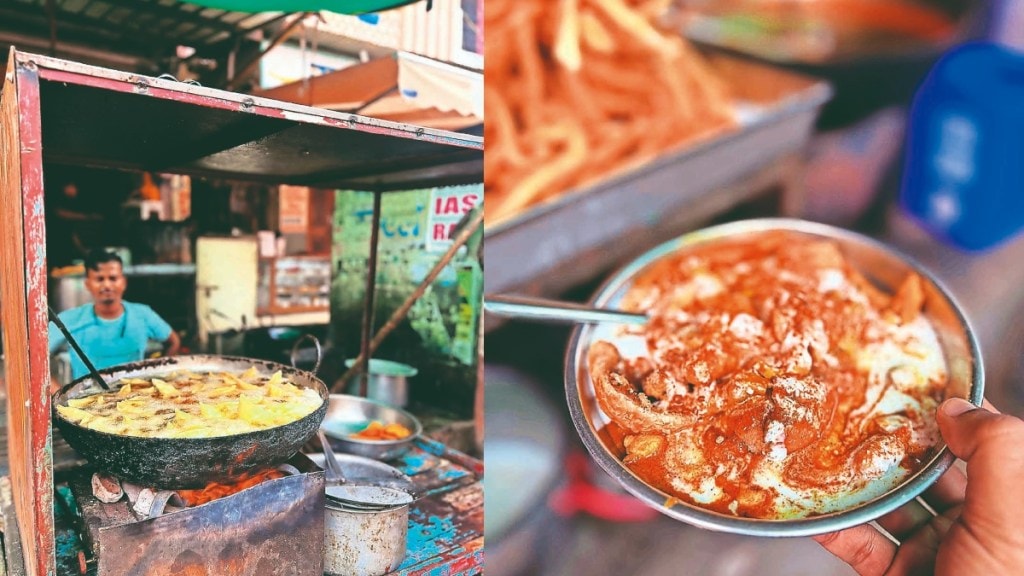By Nikhil Merchant
As a child, my annual journey to Rajasthan began with a long train ride from Mumbai to Udaipur, where we’d arrive at the city of lakes in the morning. The sleepy train station marked the start of an adventure, as we’d embark on a two-hour cab journey to Nathdwara, our temple town. My memories of Nathdwara remain vivid, with narrow lanes brimming with the calls of vendors and the heady aroma of spices swirling through the air.
Upon arrival, we’d stop for breakfast—the first taste of the town’s flavours. I remember the thick, spicy-sweet kulhad chai served in traditional earthen cups, its warmth perfectly countering the crisp morning air. Alongside, I savoured the unique purple yam chaat, crispy fried cubes dusted with laal mirch and amchur. To finish, we’d visit Shreeji Sweets in Mava Bhandar, run by Chandu Ji, renowned for his Lache Wali Rabri. Their offerings, known for Krishna Bhog at Shrinath Ji, include Heera Mani, a Bengali-inspired sweet made from pure milk, named after Chandu’s wife, Hira Bai.
This early connection to Nathdwara’s street food sparked my love for Rajasthani cuisine, a passion that would later deepen, extending beyond iconic dishes like ker sangri and laal maas.
Flavours of royalty
Rajasthan, a land of kings and warriors, has a culinary landscape as diverse and rich as its desert plains and towering forts. Each city tells its own story, distinct flavours that mirror the region’s unique heritage and their foundation lies in the hands of the age-old stores, shops, and heritage hotels.
Barwara and Udaipur, the two gems of Rajasthan, have been instrumental in showcasing the deep connections between food, history, and innovation. Each city tells a story not just through its dishes but through its markets, chefs, and produce.
In Barwara, a village near Sawai Madhopur, the food is a resilient representation of the area’s agro produce. Barwara’s most celebrated dish, Ro Saagri ki Sabji, made from native beans and berries, is the village’s unbreakable bond with sustainable ingredients. The chefs at Six Senses Fort Barwara, led by Chef Charul Srivastav, create slow-cooked Rajasthani thalis that highlight the beauty of local mustard oil, which imparts a distinct warmth to every dish. “This method is deeply rooted in the region’s culture, aligning with Ayurvedic principles of slow cooking,” says Srivastav, emphasising the fort’s rustic kitchen setup that preserves these flavours. But the chef doesn’t simply preserve the past. “We reimagine international dishes with regional staples,” she shares, showcasing innovative dishes like risotto made with barley, and salads dotted by tart ker berries, bringing sustainability to the forefront.
Barwara may be a small area, but foods from there feel like a reconnection to the land. Popular sweet shops in Chauth ka Barwara, many of them historic, family-run establishments, continue to serve traditional milk sweets that evoke nostalgia. These recipes, steeped in local wisdom, have remained unchanged for generations, often making their way into luxury settings as a symbol of Barwara’s culinary heritage. At Six Senses Fort Barwara, this experience is extended to guests.
Local women cooks from the village prepare homestyle chai for breakfast or evening tea and roll out millet-based rotis to accompany meals, bringing a true taste of the village to every plate.
This reflects in Udaipur too, with its palatial lakes and a sense of opulence. They make it a point to celebrate the agricultural richness of the region, often drawing inspiration from the royal kitchens of yore. Ambrai Restaurant, perched by Lake Pichola, offers exquisite dishes like Dal Baati Churma and Gatte ki Sabji, staples of the region’s royal culinary traditions.
At Amet Haveli, a heritage hotel that hosts the Ambrai Restaurant, local flavours are deeply influenced by local communities. Jaivardhan Singh, head of the royal family of Amet, shares, “Our Makke ke Paniye, a corn flatbread, is a true taste of the land.” Part of a traditional nine-course, corn-based meal, it showcases the agricultural abundance of Udaipur, highlighting the importance of locally sourced ingredients, including simple ones like corn. Dishes like Maans ka Soyeta, made with corn and green chickpeas, are unheard of in commercial establishments, but are served up at Amet Haveli, along with modern takes, such as Ambrai Dahi Samose ka Maas—spicy keema samosas paired with kaleji raita—which switch the narrative to a contemporary flair.
In Udaipur, the legacy of royal feasts is alive and celebrated alongside the city’s unique flavours. Dishes include Safed Maas, a mutton dish made with a rich poppy seed and almond paste, and Dhungar Maas, a smoked mutton curry that brings out the robust, smoky undertones. “We take pride in showcasing these local dishes with an attempt to reflect authentic Mewari flavours,” remarks Jaivardhan, emphasising the depth of Udaipur’s culinary heritage.
Equally unmissable is Mewari Dal, a hearty black lentil preparation that pairs beautifully with Makki ka Dokhla (corn dhokla), adding a distinct texture and flavour to the meal. Popular places to savour these dishes include JMB near Surajpol and Lala Misthan near Ghanta Ghar in the old city. Both spots are also known for preserving classic Rajasthani sweets, with delicate ghewar and mawa kachori that have retained their charm across generations.
A taste of tradition
Jaisalmer and Pushkar, though distinct in their cultural essence, share a unique culinary lineage that spans centuries. Both cities reflect the deep connection between food, geography, and heritage, yet each offers a unique experience—Jaisalmer with its hearty, spice-laden flavours suited to desert life, while Pushkar’s fare reflects its spiritual ethos with vegetarian influences.
In Jaisalmer, the winds of food history blow towards sustainability, local farming, and time-tested recipes. The Jaisalmer Halwai sweet shops—the famed Dhanraj Ranmal Bhatia near the fort, have generations of expertise passed down through the years. Their khoya and rabri are treasured by locals and visitors alike, as is the Gond pak, a traditional energy bar made from edible gum, nuts, and spices, once favoured by camel herders to withstand the harsh desert conditions during long journeys.
At the Suryagarh Jaisalmer, part of the MRS Group of Hotels, its culinary director Vijay Kumar Sahi takes the city’s food culture to new heights, reimagining desert cuisine with contemporary twists. “Our menu consists of 75% local produce,” he says, emphasising sustainability with desert-grown agricultural products.
Signature dishes like Chandolia ka Saag—a rare desert green—and Pator (stuffed millet crepes) demonstrate the resilience of desert ingredients, reflecting the creativity of contemporary chefs.
Desserts at Suryagarh include unique creations like laddoos made from a mix of pearl millet and barley, or the addictive Ghutwa Laddo made from chana, a local staple, along with an indulgent Gulabi Kheer, made with millets. The Halwai breakfast, which is a meal fit for kings, remains a favourite as it brings the city’s famous Halwai culture under one roof.
In rural areas, Junglee Maas, once a hunter’s dish made with wild boar or venison, continues to evolve. Traditionally spiced with Mathania chilies—small, sweet peppers that counteract the gamey taste —the dish now features a minimalistic four-ingredient base —fat, chillies, salt, and garlic. This simplicity, once interpreted with onions, tomatoes, and garam masala, keeps the meal grounded in its authentic form, reflecting the culture’s sustainable and responsible use of resources.
Suryagarh champions agrovoltaics, a sustainable practice that combines solar power generation with agriculture. By using solar panels to cultivate English vegetables and herbs beneath them, they integrate modern farming methods with traditional desert fare, enhancing both energy production and crop yields.
Pushkar, in contrast, weaves spirituality seamlessly into its food culture. Known for its sacred pilgrimage sites and spiritual energy, Pushkar offers a culinary experience that connects food with the town’s rituals and heritage. The sweet, syrup-drenched malpua at Sarvadia Sweet Shop is a festival staple, and so are the khasta kachoris, sold near the Brahma Temple, where generations of family recipes infuse each pastry with the rich spice and lentils which haven’t changed till date.
The town’s famous lassi shops, like Laxmi Mishthan Bhandar and Choti Wale Baba Ji Ki Lassi, located along the ghats, offer another taste of its soul. Thick, cardamom-infused yoghurt drinks, served in clay cups, offer a cooling respite from the desert heat.
At the Ananta Spa & Resort, Pushkar’s spiritual essence is reflected in its carefully curated menu. “Our prasadam-inspired menu reflects the very soul of Pushkar,” says Pradippta Biiswaas, its COO. This fine-dining interpretation of Pushkar’s temple cuisine merges the town’s street food culture with high-end gastronomy.
Dishes like malpua and kachori are given a gourmet twist, preserving the authentic flavours while celebrating modern dining techniques. With a focus on sustainability, the resort sources ingredients from local farmers, ensuring that each dish stays true to the essence of Pushkar. “We aim to provide a farm-to-table experience that presents a connection with the local community,” Biiswaas explains, describing a serene breakfast experience in the rose fields of Pushkar. Here, guests can savour a gourmet meal while immersing themselves in the fresh fragrance of blooming roses, beginning their day with a truly tranquil moment.
Savouring street food
In Jodhpur, the culinary story begins at the imposing Mehrangarh Fort, where royal kitchens (khansamas) prepare dishes like Laal Maas and Dal Bati Churma with much refined fervour. The fort’s expansive ‘open-to-the-sky’ terrace sets the stage for an immersive experience. Yet, Jodhpur’s food scene extends beyond regal feasts. The city’s iconic blue-painted houses and rich royal past serve as a gateway to a fusion of rustic traditions and royal influences.
Chandra Vilas, a local institution since 1947, captures the essence of Jodhpur’s food culture with quintessential snacks like Dal Moth and Ganthiya. Not far off, Solanki Sweets adds a patented twist to the iconic Pyaaz ki Kachori, pairing it with Panchkuta, a rare combination that highlights Jodhpur’s evolving street food scene. For a deeper dive into local flavours, Choudhary Namkeen serves the famous Mirchi Bada, a crispy deep-fried chilli stuffed with spiced potato filling—“a trip to Jodhpur isn’t complete without one,” says Varun Jalan, general manager at Daspan House.
For dessert, Mohanji Sweets offers multi-generational treats like Rabdi Ghewar and Boondi ke Laddoo, while Sattu makes its seasonal appearance during festivals. But no visit to Jodhpur is complete without experiencing its rich liqueur heritage. At Daspan House, the Heritage Liquor Experience offers a taste of Jodhpur’s historic herbal spirits, such as Kesar Kasturi and Shahi Gulab, once made in royal distilleries for their reputed health benefits.
Local gems like Old Loco Bar, where ingredients like the seasonal Balam Kakdi are used in a refreshing highball with gin, cucumber juice, and homemade pickled juice—a better utilisation of the region’s indigenous produce. At Daspan House, the culinary offerings reflect this balance of history and innovation, from Junglee Chicken—a mild but flavourful dish inspired by Rajasthan’s hunting past, to Jodhpuri Kabuli—a vegetarian take on Afghan Qabeli Palaw, that reflects the historical ties between Marwar and the Mughal Empire, and Maas Ke Sooley a slow-cooked mutton preparation that’s marinated for 24 hours in a blend of kachri (melon) powder, curd, and spices before being smoked and finished in a tandoor.
Moving on to Jaipur, the city pulses with a dynamic food culture that celebrates both the old and the new. The streets are alive with iconic snacks: the creamy lassi at Lassi Wala, crispy kachoris at Rawat Misthan Bhandar, and the street-side delights of bhujia and ghewar in Bapu Bazaar.
At The Johri Hotel, Chef Sonu Singh reinterprets traditional flavours with his Sangari ke Shammi, a modern twist on the classic ker sangri. “It’s about staying true to our roots but adapting flavours for the contemporary palate,” he shares. At his restaurant, dishes like Mohan Maas (slow-cooked mutton curry) and ghewar are reimagined in a refined form.
Bikaner, a city tucked away in the Thar Desert, mirrors its resilience in a harsh environment. The tiny city has a lot to offer in terms of heritage food. It begins with the iconic Bikaneri Bhujia, a crispy snack born from the kitchens of Maharaja Dungar Singh in 1877, and still served by local vendors like Chhotu Motu Joshi Sweet Shop. It is here that the spirit of Bikaner’s culinary history is palpable.
Yet, Bikaner’s food culture is far more than just bhujia. At Narendra Bhawan, a unit of the MRS Group, Chef Vijay Kumar Sahi takes this heritage and reimagines it for a modern diner. In India, goat meat, once predominant, is now being replaced by lamb in many menus, symbolising a return to authentic culinary traditions rather than progress. His dish Siri Paya, a gelatinous goat head stew, exemplifies Rajasthan’s “nose-to-tail” philosophy and its sustainable approach to food. “We are experiencing a culinary transformation that’s unapologetically Indian,” Sahi remarks, serving a dish that reflects the region’s historical connection to simplicity and purity of ingredients.
At Narendra Bhawan, even the humble bhujia has evolved, transitioning from street food to an upscale menu item—it is served at a chaat counter during breakfast, accompanied by millet bhel and other street food delicacies. “We strive to preserve the essence of our heritage, while creating a space for the modern diner to enjoy these authentic flavours,” Sahi explains.
The foundation of Rajasthan’s culinary identity is deeply rooted in the past, yet there is a shift happening—one that blends sustainability, creativity, and adaptability.
Nikhil Merchant is a Mumbai-born food & beverage expert, consultant and writer.








